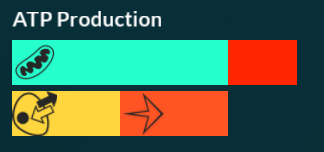currently in the microbe and multicellular stages, auto evo is like, freakishly obsessed with efficiency. if your cell isn’t as perfect as can possibly be, it doesn’t wanna see it. now, the player doesn’t need to listen to this dipshit hillbilly computer, but the randomly generated organisms around you do. because of this, almost all naturally generated cells are simple prokaryotes containing only a small handfull of parts. usually a couple of rusticyanins in the deeper patches, and a few thighlakoids in the surface ones. this has a number of negative gameplay impacts on the player. the first and most obvious being that it is simply boring. it is extremely tiring being out and about and seeing nothing but the same indistinguishable algae everywhere you go. when you do things like become eukaryotic, and god forbid multicellular, you will spend your years alone at the top, with all the dumb little fishies incapable of providing any sort of challenge or company to keep you motivated.
the other, slightly less obvious reason this is an issue, is that because the game regards complicated cells as “failures”, your own species will never branch off and evolve into other complicated forms, which further enhances the loneliness among your genus.
i feel like this can be pretty easily fought off simply by making auto evo more lenient for larger cells. the #1 cause, it seems, for smaller cells being favoured, is that they burn resources a lot slower. instead of taking that alone into account, the computer should consider only the cell’s atp balance. as you know, the higher the cell’s atp production is than its usage, the more resources it is burning for it that it doesn’t need to. that way, the computer won’t necessarily be biased towards smaller cells. as long as the cell is capable of getting resources to keep up with the rate it burns them, then it shouldn’t impact the species during selection time.
edit: i know nobody has actually commented on this yet, but i feel the need to add a little more clarity to that last paragraph.

the part highlighted in blue is the resources that the cell uses to keep itself up and running. the part highlighted in red is the resources which go straight down the shitter. basically, auto evo should focus on keeping the red part as small as possible instead of only thinking about the amount of resources burned in and of itself. the bottom bar represents the mechanical processes that the cell uses to actually attain resources, so the more complex your cell is, the easier it will be for it to get its hands on resources to burn in the first place.